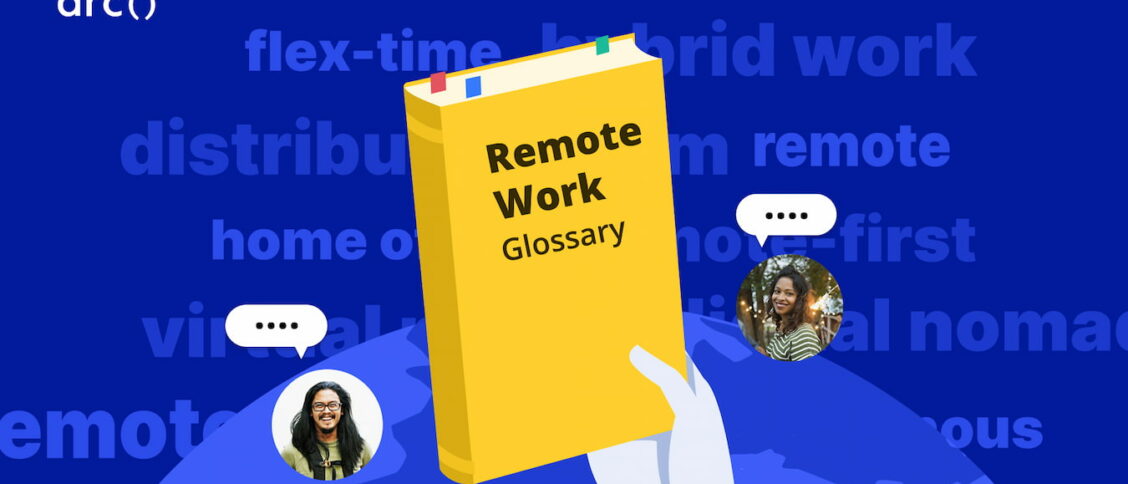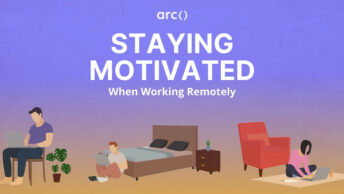What’s the difference between remote work and working from home?
Is outsourcing the same as offshoring?
What’s the meaning of remote-first? And, is that different from the definition of remote OK?
Well, you’ve come to the right place!
In this glossary of remote work terms, you’ll find definitions and explanations of important words, phrases, and lingo related to WFH and telecommuting.
Whether you’re a freelance worker, virtual employee, or in-house company representative, the terms defined below will help you make sense of the quickly evolving nature of remote work.
Looking to hire the best remote developers? Arc can help you:
⚡️ Get instant candidate matches without searching
⚡️ Identify top applicants from our network of 350,000+
⚡️ Hire 4x faster with vetted candidates (qualified and interview-ready)
Try Arc to hire top developers now →
Key Remote Work Vocabulary and WFH Definitions
Before you scroll down to the complete list of vocabulary words and phrases, it’s important to understand the nature of working remotely in general. So, to start, here are some of the most important remote work glossary terms to know:
Work From Home – Work from home, abbreviated as WFH, is when a company employee skips the office and decides to complete their tasks from the comfort of their house or apartment. Usually, this is a temporary thing, perhaps a day when the employee needs to wait for a delivery at home, can’t find a babysitter, or simply wants to concentrate on a deeper level than can be done at a loud and busy office.
Remote Work – Remote work is usually considered to be when a company employee works from home on a permanent or near-permanent basis. Their daily workspace is often a dedicated area such as a home office or fixed spot in the living room. A remote employee may visit the company’s office, if they have one, but they likely won’t have a dedicated desk or office there.
Hybrid Company – A hybrid company (also known as a hybrid-remote company) is one where a physical office exists and a portion of the employees show up physically while others tune in remotely. There are several types of hybrid working environments, including the office-centered hybrid model (employees get a day or two where they’re allowed to work from home) all the way to a remote-first hybrid model (the company is mainly online, but a physical office exists for those to visit when they so choose).
Distributed Company – A distributed company is one where its employees are spread out across various regions or countries, often in different time zones. While there may be one or several physical offices, a substantial number of the employees are considered remote workers. Having a distributed workforce means that most, if not all, of the company’s programs and resources must be available online in the cloud.
Read More: How to Work From Home Successfully
Complete Remote Work Glossary of Terms
All-Remote Company – An all-remote company is one in which there is no physical office or headquarters location, and every employee, including executives, works completely remotely. An all-remote organization may still have an address for administrative purposes.
Annualized hours – Annualized hours refers to the total number of hours worked or to be worked in one year. Some distributed organizations use annualized hours to allow both the company and its employees more flexibility. For example, rather than requiring employees to work 8-hour days, the company may institute a 1920-hour yearly contract. This enables companies to respond to busy periods or emergencies with employee labor which can be deducted at other, slower times. It also allows employees to choose the most convenient working schedule for themselves, rather than requiring a 9–5 sort of schedule, especially helpful for creative-type jobs.
Asynchronous Communication – Asynchronous communication is when information is exchanged amongst a team or group of employees without the need for or expectation of a timely response. This form of communication is commonly used in distributed workforces, particularly when various members of the team are located across different, distant time zones and locations. You can read more on this in our article about asynchronous vs synchronous communication.
Blended Team – A blended team is one made up of both full-time employees and contract talent working together on the same project and goals. Blended teams are popular in smaller or newer startups, particularly when a company can’t afford to fully employ the necessary people required.
Brick-and-Mortar – Brick-and-mortar describes a physical location, such as a traditional clothing store with a street address that customers can visit, as opposed to an online location.
Read More: How to Create a Remote Work Culture That’s Supportive, Positive & Fun
Cloud Storage – Cloud storage refers to the ability to store, edit, and access data from anywhere through the internet, as opposed to physical storage of files or local servers which can only be accessed from within a single company network. Examples of cloud storage providers include Dropbox, Google Cloud Platform, Amazon Web Services, and others.
Co-Located Team – A co-located team is one whose members are all in the same location. While a co-located team usually implies that all its members are physically together in the same office space, it is sometimes used to refer to a team where members are located relatively close to each other (same city or country or time zone) versus a “distributed team” (see definition below).
Coworking – Coworking is where people from different companies work together in the same physical location (a “coworking space,” see below). Coworking has become popular for people on distributed teams or freelancers, as it enables them to have physical human interaction with others while being located far from their own colleagues.
Coworking Space – A coworking space is an office environment set up specifically to meet the needs of individual employees working remotely, freelancers, and smaller companies. A single person or a group of people can rent out a desk or office within the coworking space at a much lower cost and a much more flexible length of time obligation than would be the case with traditional office space. Many coworking spaces offer perks, equipment, payment and invoicing, and services common in top startups, such as lounge areas, a refreshments area, a receptionist, daily cleaning services, phone booths, and more.
Compressed Working Week – A compressed working week is one where an employee works the standard 40 hours in a shorter period of time. For example, rather than working 5 8-hour days per week, a compressed workweek could be 4 10-hour days.
Cybervetting – Cybervetting is a form of screening hiring managers and potential employers use to assess prospective hires’ online reputations and internet presence. For software developers, this is a step before the developer vetting process, which assesses and verifies specific technical skills and programming language proficiency levels.
Read More: Hiring In-House vs Remote Developers: Cost & Competitive Advantages
Dematerialization – Dematerialization refers to the process of transitioning a company and its processes from physical locations and infrastructure toward their digital counterparts. Dematerialization goes hand in hand with digitalization.
Digital Nomad – A digital nomad is someone who wanders from place to place, enabled by remote — often freelance — work which gives them the freedom and flexibility to do so.
Digital Presenteeism – Digital presenteeism is the act of showing up for remote work while exhibiting a lack of productivity, usually due to sickness or being plagued by personal issues and thoughts. People who work from home may not take a personal day or sick day when they would have had they gone to work physically, and this may lead to digital presenteeism. Remote workers on vacation might also decide to continue working with low productivity, simply because they can still sign in, thus saving their vacation days.
Distributed Company – A distributed company is one where its employees are spread out across various regions or countries, often in different time zones. While there may be one or several physical offices, a substantial number of the employees are considered remote workers. Having a distributed workforce means that most, if not all, of the company’s programs and resources must be available online in the cloud.
Explicit Communication – Explicit communication is the kind that is clearly stated and easily understood. Because of the distributed, often asynchronous nature of remote work, explicit communication is a required skill, particularly when working with colleagues who have different primary languages.
Face-to-Face Meeting – A face-to-face meeting, sometimes abbreviated as an “F2F meeting,” is essentially a physical meeting, an in-person meeting as opposed to one which takes place digitally over Zoom, for instance.
Flex Time – Also known as “flexi time” or “flexible time,” flex time refers to an employee’s daily schedule where they aren’t strictly required to work the normal 9–5 or even hours back to back. With flex time, a worker can choose when to work to accommodate their productivity levels, personal responsibilities, and other engagements. For example, a remote employee with flexi time may take their child to school, work for a few hours, pick their child up, then work late in the evening again once their child goes to bed.
Read More: Diversity & Inclusion in Remote Work: 12 Things You Need to Know
Freelance Work – Freelance work is an outsourced task or project performed by temporary, contract-based workers (“freelancers”) as opposed to being done by internal employees.
Freelancer – A freelancer is someone who performs work on a contractual, temporary basis, often for a single gig or project. Freelancers are not employed by the company, and so they may take several projects on from different clients simultaneously.
Future of Work – The future of work refers to predictions about, and the study of, what is to come as far as employment processes, careers, workplaces, work modes, and workforces. Research into this topic can lead to both pessimistic and optimistic predictions on what the future looks like, and it includes insight into economic migration, job creation, rising and falling industries, economic inequality, workers’ rights, and much more.
Gig Economy – The gig economy refers to the portion of the labor force that involves on-demand services, freelance work, and short-term contracts, including the freelancers (called “gig workers,” in this case), contractors, companies, and facilitating middle platforms that make it all happen.
Great Resignation – The Great Resignation is a recent post-pandemic socio-economic trend involving a mass exodus of workers switching careers, leaving their current jobs, changing course to be stay-at-home parents, retiring early, or otherwise adjusting their professional lives. Since the global coronavirus crisis began in early 2020, many in the workforce have decided to better account for personal priorities, inflexible employers, a renewed focus on education, and other factors by reviewing and shifting their career goals.
Home Office – A home office is a specially designated area in someone’s apartment or house which serves as their remote workspace.
Hybrid Company – A hybrid company (also known as a hybrid-remote company) is one where a physical office exists and a portion of the employees show up physically while others work remotely. There are several types of hybrid working environments, including:
- the office-centered hybrid model (employees get a day or two where they’re allowed to work from home), all the way to
- a remote-first hybrid model (the company is mainly online, but a physical office exists for those to visit when they so choose).
Read More: Understanding Remote Team Personalities Gets Your Messages Heard
Implicit Communication – Implicit communication is the kind of messages and signals someone makes, both intentionally and unintentionally, outside of direct verbal communication (see “explicit communication”). This can include body language, facial expressions, hand gestures, tone of voice, the choice of words, timing, and a whole lot more. Implicit communication can also be interpreted through one’s actions, attitude, and deeds over a period of time, and it is very much open to interpretation. This kind of communication can be more difficult to convey when one or more remote workers are involved.
In-Person Meeting – An in-person meeting (also known as a “face-to-face meeting”) is simply one where attendees are physically present, as opposed to virtual meetings over Skype, Zoom, or Microsoft Teams and distance meetings such as on the phone or on Clubhouse.
Knowledge Worker – A knowledge worker is someone whose employment or freelance contracts involve working with information, as opposed to performing tasks with crucial physical components. Knowledge workers include software developers and engineers, graphic designers, accountants, social media managers, content writers, editors, scientists, academics, lawyers, and others. Many knowledge workers have no need for physical office space, so they are well-equipped to be employed in flexible or fully remote environments.
Offsite Meeting – An offsite meeting is a physical company meeting that takes place outside the office. Offsite meetings are often used to boost morale and team bonding, gather a distributed company together in one place, announce upcoming developments or goals, or celebrate a recent success, among other things.
Offshoring – Offshoring is a business practice where some internal operations and processes move abroad, usually for tax incentives, lower employee salaries, or to take advantage of a workforce with specialized skills. With offshoring, the company still retains full control over the foreign entity, usually by setting up a satellite office and registering in the new country as a business.
Online Vetting – See “Cybervetting.”
Onsite Meeting – An onsite meeting is essentially a physical company meeting taking place at the office. Generally, however, it implies a larger event than the standard team or company meeting, perhaps with guest speakers, catering, breaks, presentations, and possibly even key stakeholders, customers, prospective clients, and sponsors.
Outsourcing – Outsourcing is a business practice where operations, processes, production, or other activities are transferred to a third party. This is normally done to save costs, reduce time, or enable a product or service that couldn’t otherwise be performed in-house.
Remote Employee – A remote employee or remote worker is someone who is hired by a company but performs their work outside the company’s offices (if a physical workplace even exists).
Read More: How to Conduct a Remote Technical Interview Successfully
Remote OK – See “remote-friendly.”
Remote Work – Remote work is usually considered to be when a company employee works from home on a permanent or near-permanent basis. Their daily workspace is often a dedicated area such as a home office or fixed spot in the living room. A remote employee may visit the company’s office if they have one, but they likely won’t have a dedicated desk or office there.
Remote-First – A remote-first company is one that primarily hires employees who will work away from the physical office space. A remote-first company may hire key personnel to work in the central office or in satellite offices, but the majority of its staff will be remote. All business processes are optimized to make location irrelevant.
Remote-Friendly – Also known as a “remote OK” company, remote-friendly refers to an organization that empowers its employees to work remotely, if they choose to do so. However, it may require some meetings or entire days at the office each week.
Retreat – A retreat, often called a company retreat, is an offsite event minimally or not at all focused on work. Instead, the goals of a company retreat are to improve morale, increase team bonding, allow team members to interact with colleagues they don’t often work with, and simply relieve stress and recharge energy.
Satellite Office – A satellite office is a secondary physical space of a company that is not a headquarters or primary office. Satellite offices are often situated in smaller cities and usually have far fewer employees than an HQ or any of the company’s main offices.
Single Source of Truth – A single source of truth (SSOT), sometimes known as simply a source of truth, is a practice where all information, data, instructions, and other details on a given subject is documented in one place. By implementing a single source of truth, employees across the company have access to the latest, most accurate information at any given time. Everyone gets the same data, which allows remote employees, in-house staff, external contractors, and potentially others (investors, clients, etc.) to operate more efficiently and intelligently.
Read More: How to Transition to a Remote Engineering Team: The CTO’s Cheat Sheet
Software as a Service – Software as a service, abbreviated as SaaS, is a business model where software is licensed to be used via a subscription, as opposed to buying the software outright.
Solopreneur – A solopreneur is essentially a single person who’s created their own business. It is a portmanteau of “solo” + “entrepreneur.”
Synchronous Communication – Synchronous communication is information relayed and received in real-time, such as a phone call or face-to-face conversation.
Telecommuting – While often used synonymously with “working remotely,” telecommuting (sometimes referred to as telework) more resembles the definition of “working from home,” because it doesn’t necessarily mean the employee is permanently remote.
Video Chat – A video chat is a form of communication using both a video and sound held over the internet. Video chats are a form of synchronous communication and are sometimes referred to as a virtual face-to-face conversation.
Virtual Assistant – A virtual assistant is someone who provides various kinds of support from a distance. In many cases, virtual assistants are external employees (freelancers), though a company may hire a virtual assistant as an employee (to be something of a remote research assistant, for example). Virtual assistants may use both synchronous and asynchronous communication, and they can help with tasks involving administrative efforts, research, technical help, creative support, and other services.
Work From Home – Work from home, abbreviated as WFH, is when a company employee skips the office and decides to complete their tasks from the comfort of their house or apartment. Usually, this is a temporary thing, perhaps a day when the employee needs to wait for a delivery at home, can’t find a babysitter, or simply wants to concentrate on a deeper level than can be done at a loud and busy office.
Workation – A workation (a portmanteau of “work” + “vacation”) is where an employee will take a holiday, trip, or vacation and still perform some or all of their usual duties. Remote employees often use their location flexibility to get some rest and relaxation in away from their homes and personal lives without having to take paid time off.
Read More: The Best Remote Work Tools to Use According to Top Distributed Teams
You can also explore HireAI to skip the line and:
⚡️ Get instant candidate matches without searching
⚡️ Identify top applicants from our network of 350,000+ with no manual screening
⚡️ Hire 4x faster with vetted candidates (qualified and interview-ready)
Try HireAI and hire top developers now →
Other Resources to Help You Understand Working Remotely
To wrap up this glossary of work-from-home vocabulary and virtual employment terminology, here are a few links to resources that may provide you with further information and insight into the world of remote work:
- List of the Best Job Boards for Remote Tech Jobs
- How to Negotiate Salary or a Raise as a Remote Developer
- What’s the Difference Between a Phone Screen and a Phone Interview?
- Here’s How to Prepare for a Video Interview Properly
- Don’t Make These Common Remote Interview Mistakes!
- The Salary Guide: How Much Do Remote Software Engineers Make?
- How to Write a Remote Software Engineering CV
- A Guide to Every Technical Interview Question From All Major Tech Stacks
And finally —
Whether you’re looking for WFH opportunities as a software developer, data analyst, or QA automation engineer, Arc delivers. On our job board, we have thousands of the latest remote jobs from top companies around the world, including GitHub, Fastly, Stripe, and others.
For those of you on the other side of the virtual table (as in you’re hiring remote workers), Arc helps you find top talent anywhere in the world. And, we don’t just match you with potential candidates.
Our pool of global developers is pre-verified through a Silicon Valley-caliber vetting process where only 1.1% of candidates pass our rigorous technical & behavioral assessments. You can rest assured that you’ll interview perfectly matched developers, and hire up to 4x as fast while doing so!
Read More: Slack Emojis ✌️ Our Team’s Secret to Effective Remote Collaboration

Arc is the best place to find great remote jobs. Find great remote jobs at top startups and tech companies. Freelance and full-time remote opportunities are available.
Sign up here








